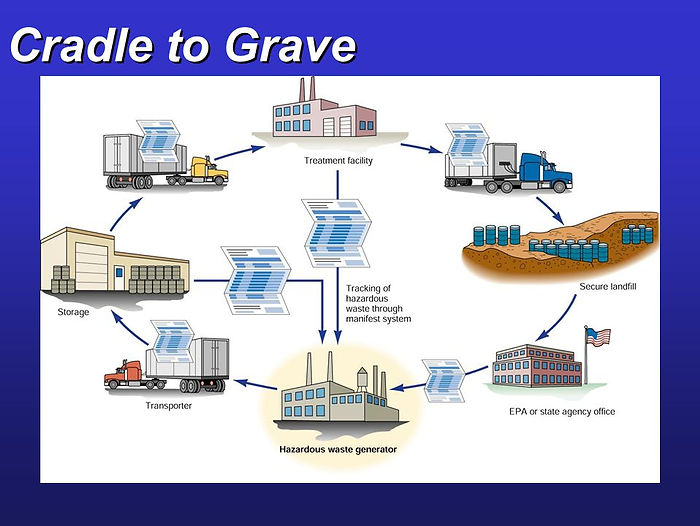Cradle to Grave
What is the first thing that you think about when you hear the term cradle to grave? The cradle is where you start life, and, of course, the grave is where you end it. In business, the term cradle to grave is used in reference to a firm’s perspective on the environmental impact created by their products or activities from the beginning of its life cycle to its end or disposal.

What is meant by the cradle to grave principle
What does it entail? A brief explanation of the importance behind this term often used and/or misused by organisations.
Cradle to grave are more referred to these days but are often misleading or understood wrong. This term is better understood when referred to as “from creation to disposal”. Most Organizations are only focused on hazardous waste cradle to grave, but the general/domestic waste could potentially also pose a risk; whether it might be social, environmental or health.
The best route to determine your cradle to grave is to establish a life cycle of the Organizational processes. Only once you have narrowed down your process will you be able to see precisely what waste streams you have within your Organization. Each waste stream will have a different cradle to grave and this is where the Organization can implement:
· proper identification of each risk,
· necessary handling procedures and,
· correct storage requirements.

The main goal of cradle to grave is to assist an Organization to determine whether the waste stream can be recycled, perhaps even re-used as the last resort will be landfill/disposal. If the cradle to grave is not utilized correct, there might be liability aspects, severe penalties from the Government and perhaps even environmental pollution.
To best determine whether your Organization are equipped to follow a cradle to grave scenario ISO 14001:2015 is an excellent standard and guidance document to ensure all waste streams are treated with the necessary respect and that organizations are utilizing their cradle to grave process to optimize ecological and social benefits.
The life cycle perspective is dependent on the organisation scope and services provided, and the scope can vary based on contractual obligations imposed by the client. The life cycles of ISO 14001:2015 are broken up into life cycle perspective, life cycle stages, and life cycle assessments. The words life cycle are mentioned 14 times in this standard, with specific emphasis on the words life cycle perspective, which according to ISO 14001:2015 White Paper “Getting a management perspective on life cycles” states that life cycle perspective is “the extent to which the organisation can control or influence over the various life cycle stages and how that extent will be a crucial factor in the breathe of the perspective considering the whole cycle.”

“When applying a life cycle perspective to its products and services, the organization should consider the following:
· the stage in the life cycle of the product or service,
· the degree of control it has over the life cycle stages, e.g. a product designer may be responsible for raw material selection, whereas a manufacturer may only be responsible for reducing raw material use and minimizing process waste and the user may only be responsible for use and disposal of the product,
· the degree of influence it has over the life cycle, e.g. the designer may only influence the manufacturers production methods, whereas the manufacturer my also influence the design and the way the product is used or its method of disposal,
· the life of the product,
· the organization’s influence on the supply chain,
· the length of the supply chain, and
· the technological complexity of the product.
The organization can consider those stages in the life cycle over which it has the greatest control or influence as these may offer the greatest opportunity to reduce resource use and minimize pollution or waste.”
Application for Certification
Join our mailing list to receive upcoming posts: http://www.isoqar.co.za/

